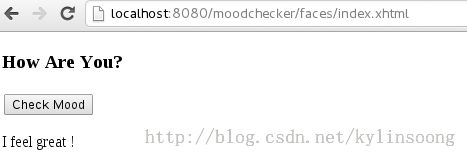JBoss 系列七十:一个简单的 CDI Web 应用
概述
本文通过一个简单的 CDI Web 应用演示dependency injection, scope, qualifiers 以及EL整合。应用部署完成后我们可以通过http://localhost:8080/moodchecker 来访问Web 应用欢迎页面,Mood在good和bad之间不停变化。通过本文,我们可以明白how qualifiers influence the selection of an injector。
编译部署测试应用
本应用源代码位于 https://github.com/kylinsoong/webframework/tree/master/cdi/moodchecker。
我们可以使用软件安装及资料下载中描述的方法下载,编译生成部署包cdi-moodchecker.war,使用使用4种方式部署应用到JBoss7/WildFly中描述的方法部署cdi-moodchecker.war到JBoss节点。应用部署完成启动JBoss 7如下:
./standalone.sh
应用部署完成后我们可以通过 http://localhost:8080/moodchecker 访问,Web页面显示如下:

示例分析
示例涉及到的配置文件或java类包括:
- beans.xml
- faces-config.xml
- index.xhtml
- web.xml
- jboss-web.xml
- org.jboss.demo.cdi.moodchecker.Mood
- org.jboss.demo.cdi.moodchecker.BadMood
- org.jboss.demo.cdi.moodchecker.GoodMood
- org.jboss.demo.cdi.moodchecker.MoodChecker
Mood
Mood类内容如下:
import javax.enterprise.context.RequestScoped;
import javax.inject.Inject;
import javax.inject.Named;
@Named
@RequestScoped
public class Mood {
private String mood;
@Inject
@Good
private MoodChecker moodChecker;
public Mood() {
}
public void check() {
mood = moodChecker.checkMood();
}
public String getMood() {
return mood;
}
}
注意:@Named 和 @RequestScoped标注类本身,MoodChecker属性使用@Inject和@Good注入。
Qualifiers
注意前面Good是我们自定义的标注,用来注入GoodMood,我们这里创建了两个标注,Good和Bad,如下:
import java.lang.annotation.Documented;
import java.lang.annotation.Retention;
import java.lang.annotation.Target;
import javax.inject.Qualifier;
import static java.lang.annotation.ElementType.FIELD;
import static java.lang.annotation.ElementType.METHOD;
import static java.lang.annotation.ElementType.PARAMETER;
import static java.lang.annotation.ElementType.TYPE;
import static java.lang.annotation.RetentionPolicy.RUNTIME;
@Qualifier
@Target({ TYPE, METHOD, PARAMETER, FIELD })
@Retention(RUNTIME)
@Documented
public @interface Good {
}
我们使用 Good标注GoodMood,如下所示:
@Good
public class GoodMood implements MoodChecker {
public String checkMood() {
return "I feel great !";
}
}
这样当在 Mood中使用@Good标注时会注入GoodMood。
EL整合
index.xhtml使用EL表达式与后台Bean Mood直接交互,index.xhtml内容如下:
<!DOCTYPE html PUBLIC "-//W3C//DTD XHTML 1.0 Transitional//EN" "http://www.w3.org/TR/xhtml1/DTD/xhtml1-transitional.dtd">
<html xmlns="http://www.w3.org/1999/xhtml"
xmlns:h="http://java.sun.com/jsf/html"
xmlns:f="http://java.sun.com/jsf/core">
<h:head>
<title>How Are You Today?</title>
</h:head>
<h:body>
<h3>How Are You?</h3>
<h:form>
<p>
<h:commandButton value="Check Mood" action="#{mood.check}" />
</p>
<p>
<h:outputText value="#{mood.mood}" />
</p>
</h:form>
</h:body>
</html>